Before answering the question that brought you to this page: how to test the generator with a multimeter? - I would like to recall the role of this vehicle assembly.
A car generator is that technical unit of a car, thanks to which we can not only move from point A to point B, but do it comfortably and safely. It is undeniable that electricity has become a very dense part of our lives and without it we are sometimes very uncomfortable. And, to be honest, it is unlikely that a modern car would go anywhere at all without electricity. Too many systems won't work without it.
For those who remembered the battery, I will only answer that in cars with an internal combustion engine, the battery was created primarily to start the engine, and without constant energy supply from the generator, it will not pull for a long time.
Why do I remember all this? And in order to remind you that such vital elements of the performance of your car should be under primary control. After all, nothing is eternal.
Well, in order to check the operability of the generator, so to speak, to conduct its express testing, you will need a multimeter - a multifunctional device for measuring voltage, current, resistance, etc. In our case, you will need only one of its main functions - voltage measurement.
How to check the voltage of the generator with a multimeter?
So let's get started.
First, open the hood or other place where you have the battery and measure its voltage with the engine off. If it is about 12.6 V and higher, then most likely everything is in order with your battery, and if it is less (12.3 V, for example), then this will indicate a discharged battery, which is an indirect sign of problems with the generator.

However, not always only the generator can be to blame for this, sometimes the battery itself needs to be replaced.
Let's move on. We start the engine, warm it up to operating temperature. For those who do not know how to determine this moment, I will note that the radiator fan turned on once (provided that it is not winter with very low temperatures).
We measure the voltage on the battery again, under the following conditions: the engine is idling, all electrical consumers are turned off, and everything that can be turned off must be de-energized. The reading of the multimeter in this situation should be about 14 V.
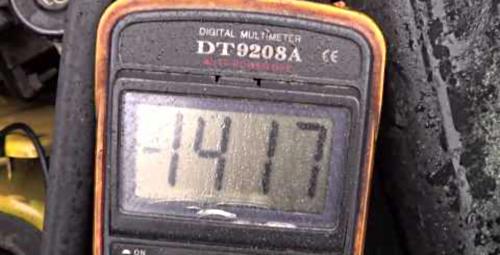
Without reducing the engine speed, we turn on the headlights of the car to start, controlling the voltage drop, then we add other powerful consumers to the headlights, such as heating windows, mirrors, seats, blowing, etc. There is only one condition here: we turn on only standard systems, so if If you yourself understaffed the car with a powerful stereo system, then you should not turn it on at the time of diagnosis.
After turning on all the basic electrical consumers, the voltage that the multimeter shows should not fall below 13 V.
If everything is normal and when checking with the consumers turned off, the voltage did not greatly exceed 14 V, your generator is in good condition and produces required voltage. If not, then there is a malfunction somewhere and it must be identified. How? The topic of a separate article.
Finally, a few words about why when I talked about turning on consumers, I focused on the fact that only standard electronics should be turned on. The answer is simple. The fact is that the automaker, when installing a generator on a car, selects a model of it that will provide regular electrical preparation with a small margin. Therefore, if you yourself have installed a powerful stereo system with a separate amplifier and powerful acoustics, then it is far from a fact that even a workable generator will draw all this power. Accordingly, a sagging voltage below 13 V during the operation of electrical consumers installed by someone other than the manufacturer does not mean that the generator is faulty.
In a car, the main source of electricity is the generator. If the alternator fails, the battery will not charge. As a result, electrical appliances are gradually de-energized, making it impossible for the car to continue further movement. That is why it is very important to always monitor the performance of this most important automotive unit.
Alternator malfunction may manifest itself different ways. If extraneous noise suddenly appears in the node, or the battery is not fully charged or does not exist at all, then all these signs indicate a possible imminent failure of this device.
You need to pay attention to the generator, for example, in this case, if nothing happened when you tried to start the car, and you lit a cigarette from another vehicle. Then you drove a certain distance, and after stopping while trying to start the car engine again, you failed again. In such a situation, perhaps the generator is out of order and does not charge the battery, or the battery itself has served its purpose. Another cause could be a blown battery charging fuse.
Alternator Mechanical Troubleshooting

There is nothing complicated here. If extraneous noise, hum, whistle is heard, then this may be a sign of failure of the bearings that are inside the generator. They must be checked for wear. If this is confirmed by visual inspection, then they should be replaced with new ones. As a rule, the cost of generator bearings is not very high.
In addition to bearings, noise can appear due to interturn short circuits in the windings of the solenoid relay or stator. Shorting the windings to the case can also cause extraneous noise. Generally speaking, during the mechanical interaction of various elements of the generator, during its operation, an unpleasant sound appears. Such malfunctions can be detected during a visual inspection of the generator, since such an interaction of parts must necessarily leave traces. Assessing the severity of the malfunction, it will be possible to conclude that the generator is maintainable. But the listed defects are not the only ones.

As a result of checking the output voltage of the generator, you can establish the degree of its performance and find out the causes of failure. For this procedure, a voltmeter is most often used connected to the poles of the battery. Sometimes, but less often, a multimeter or ohmmeter is used. The voltage at the terminals must be within 8 V during engine start. It is advisable to make such measurements on a warm engine.
Then it is necessary to increase the engine speed to 3000 in order to activate the battery charging process and again measure the voltage at the battery terminals. If the readings on the voltmeter are below 12.5 V, then the battery is not charging enough, and you should think about repairing the generator.
Before dismantling a faulty generator, it is necessary to disconnect the ground terminal from the battery. Then, with a screwdriver, you need to unscrew the fasteners from the voltage regulator. Further, after dismantling the generator, it is imperative to make a visual inspection of it, before further more thorough diagnostics. During this, you need to clean the slip rings from carbon deposits, if any, and also assess the wear of the generator brushes. One of common causes generator failure is the failure of the voltage regulator. It is recommended to change it periodically, without waiting for the expiration date.
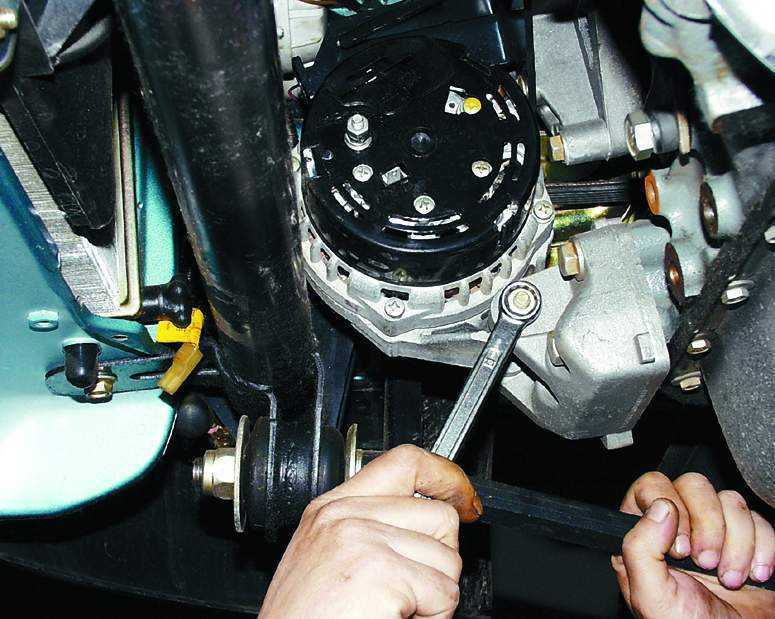
Installing the generator in place occurs in the reverse order. At the end of the installation of the generator, you need to connect the ground terminal to the battery. When the generator is mounted in its place, you need to start the car engine again and raise the speed to 3000 per minute. If the voltmeter readings are not lower than 13.5 V, then this means that the generator malfunction has been eliminated.
Further, without turning off the engine, you need to check the voltage stabilization. For this simple procedure, you need to turn on the car headlights in high beam mode and measure the voltage again. If the deviations of the voltmeter readings will not exceed 0.4 V from previously obtained results, then there is nothing to worry about. As can be seen from the foregoing, all these procedures are quite within the power of any motorist with a standard set of tools, the skills to use them and a voltmeter.
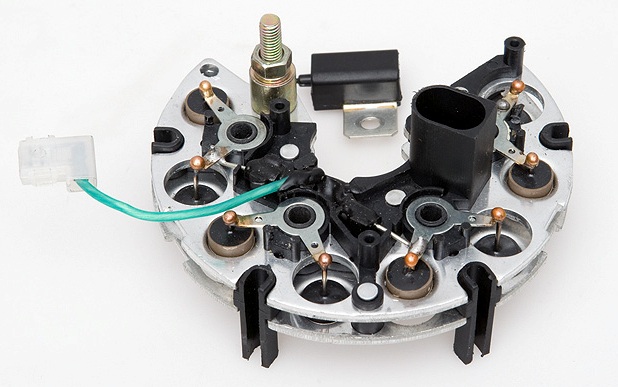
It is possible to check the automotive energy saving circuit using various measuring instruments. In order to check the diode bridge, you need to attach a voltmeter to the "mass" and the generator clamp. A voltage indicator exceeding 0.5 V will indicate a diode malfunction. To determine their breakdown, it is necessary to connect a voltmeter to the disconnected wire of the generator and to terminal "30". If the current readings do not exceed 5 mA, then everything is in order.
To check the voltage regulator, you must pre-warm the engine for 15 minutes with the headlights on. Then, using a voltmeter, you need to measure the voltage at the output "30" and at the "mass". Indications for different cars are different. Additionally, you can check the regulated voltage of the car. To do this correctly, you must turn on all devices that consume energy, and raise the engine speed closer to maximum. For each modification of the car, these results will be individual.
In order to check the resistance in the excitation winding, a multimeter or ohmmeter is used. First you need to dismantle the brush holder and voltage regulator. Then, after making sure that there is no damage to the winding, it is necessary to clean the slip rings, since the contacts measuring device during the resistance test, they are attached to them. Indicators of 5-10 ohms are considered within the normal range.
A multimeter will help check for a short to ground. To do this, one of its probes must be connected to the slip ring, and the second to the generator stator. If there is no short circuit, then the resistance on the multimeter will be shown infinitely large.
As can be seen from the above, it is possible to diagnose the generator and eliminate many of its malfunctions with your own hands. For more complex repairs, it is better to contact specialists at certified service stations.
As the saying goes, "No one is indispensable." But in the case of a car, you can make an exception. Have Vehicle such a detail, which is the most important part and truly irreplaceable, is a generator, which is a kind of small power plant. This is the main source of electrical power. If any malfunctions occur in it, this will cause poor battery charging or even the absence of one. Therefore, every motorist must be sure that the generator in his "favorite" is functioning properly. So that such confidence does not leave you, it is necessary to periodically diagnose this element. In this article, we will tell you how to properly diagnose car alternator.
It's no secret that the priority place for checking a car generator is a specialized car service. But this does not mean at all that it is unrealistic to conduct a correct diagnosis of the unit in the conditions of your own garage, using your knowledge, skills and strengths.
 Before you start diagnosing a car generator, you need to purchase a special device that measures voltage. And we are talking, of course, about the multimeter. There are many places where you can find recommendations obliging car owners to stock up on a tester, avometer, voltmeter and ammeter, but we declare with confidence that all these devices are almost identical, and minor differences are only in the set of additional functionality. Choose what is more familiar and convenient for you, each of the listed devices is suitable for conducting an independent voltage test on a car generator.
Before you start diagnosing a car generator, you need to purchase a special device that measures voltage. And we are talking, of course, about the multimeter. There are many places where you can find recommendations obliging car owners to stock up on a tester, avometer, voltmeter and ammeter, but we declare with confidence that all these devices are almost identical, and minor differences are only in the set of additional functionality. Choose what is more familiar and convenient for you, each of the listed devices is suitable for conducting an independent voltage test on a car generator.
While checking the mini power plant of your car each owner is obliged to know and remember what is forbidden to do:
1. Check the level of generator performance by short circuit.
2. Connect terminals such as "30" and "67", which are responsible for the mass (in some cases they are encrypted as "B +" and "D +").
3. Forcibly turn on the generator without consumers connected to it. Disconnecting the battery is strictly prohibited.
4. Welding a car body with wires connected from a battery and a generator.
More motorist must not forget that:
Naturally, someone else's help is required. The assistant will not have to do anything super complicated, so you should not get hung up on finding specialist mechanics. This is just the case when you can even ask your other half to help you.
Checking the generator valves should be carried out under voltage not exceeding 12V.
If you need to replace the wiring of the generator, then you need to select only those wires whose cross-sectional and length indicators are similar.
 Before diagnosing all the elements of a mini power plant, it is recommended to check all connections and the tension of its belt. If the first part is clear, then we will concretize regarding the belt. The correct tension of the alternator belt can be considered rightfully correct only if, when you press on its middle with a force of 10 kg / s, it bends by a maximum of 15 mm, but no more.
Before diagnosing all the elements of a mini power plant, it is recommended to check all connections and the tension of its belt. If the first part is clear, then we will concretize regarding the belt. The correct tension of the alternator belt can be considered rightfully correct only if, when you press on its middle with a force of 10 kg / s, it bends by a maximum of 15 mm, but no more.
Visual diagnostics of the generator
Sometimes one or the other possible problems with a generator can be determined thanks to the battery charge control indicator. If the indicator lamp does not light up when the ignition is turned on, this phenomenon may be accompanied by:
Faulty battery;
Faulty control lamp;
Violation of the integrity of the wires of the indicator circuit or contacts;
Wear of the generator brushes or poor contact on the brush assembly;
Faulty voltage regulator.
In cases where the indicator is constantly lit, regardless of the operating mode of the power unit, the following malfunctions may occur:
1. Worn or loose alternator drive belt;
2. Breakdown of diodes in the diode bridge circuit;
3. Short circuit stator winding, as well as a possible break;
4. Malfunction or failure of the voltage regulator settings.
How to check the generator with your own hands?
 Correctly diagnosing a car generator is a rather complicated task, so a clear sequence of certain actions is necessary here. First of all, you need to check the generator relay, then the diode bridge, then the stator, and finally the rotor. In this situation, it is better not to improvise and not to invent, but to act strictly according to plan.
Correctly diagnosing a car generator is a rather complicated task, so a clear sequence of certain actions is necessary here. First of all, you need to check the generator relay, then the diode bridge, then the stator, and finally the rotor. In this situation, it is better not to improvise and not to invent, but to act strictly according to plan.
An overvoltage in the vehicle's on-board network can cause many devices to stop working. A relay-regulator is necessary to maintain the correct potential difference. To check this element for normal operation, you must:
1. Switch the multimeter to voltage measurement mode.
2. Start the car engine.
3. Measure the voltage level at the battery terminals or at the generator terminals. The voltage should fluctuate between 14-14.2 V.
4. Click on . This is what the same assistant we mentioned earlier will have to do. The voltage should move upwards by no more than 0.5 V. If the deviation exceeds the norm, then the relay-regulator is faulty.
 This device consists of six diodes combined into plates, one of which is negative, and the second, therefore, is positive. The mass of three diodes is on the cathode, the other three are on the anode. The check is carried out according to the following scheme:
This device consists of six diodes combined into plates, one of which is negative, and the second, therefore, is positive. The mass of three diodes is on the cathode, the other three are on the anode. The check is carried out according to the following scheme:
1. Turn the multimeter into ohmmeter mode.
2. Connect one probe to the positive terminal of the device, and connect the other in turn to the following terminals: "F1", "F2", "F3" and "0". That is, the first probe remains connected to the plate with a positive value, and the second probe in turn touches the terminals of the diodes pressed into this plate.
3. Swap the probes and repeat the procedure. In one of the cases, the multimeter should show conductivity, that is, resistance of any kind, and in the other, not. This test is carried out on the positive plate with diodes.
4. Attach one probe to the negative plate, the other to the diode leads.
5. Repeat the same operations as in the case of the positive plate. And again, conductivity will be in one of the cases. So passed the test of the negative plate.
Please note that the resistance must necessarily exceed the zero value. If this is not the case, then there is a high probability that the diode has broken through. This phenomenon can also be indicated by the fact that there is no resistance in both directions during the connection process. Diode bridge can distribute insufficient charge even with one serviceable diode, so it is urgent to replace this element.
This block looks like a hollow metal cylinder with generator windings neatly stacked inside it. Checking this element should take place according to the following plan:
1. Disconnect the starter terminals from the diode bridge.
2. Visually check the condition of the winding. It must not show any damage of any kind.
3. Put your multimeter in resistance test mode.
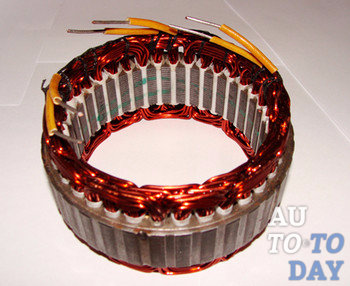 4.
Check the winding for breakdowns: measure the resistance between the stator housing and any winding terminal. This value, oddly enough, belongs to the category "the more the better." The ideal option is the desire for infinity with a multimeter going off scale. The device must give a resistance of at least 50 kOhm. Otherwise, the car generator will soon fail.
4.
Check the winding for breakdowns: measure the resistance between the stator housing and any winding terminal. This value, oddly enough, belongs to the category "the more the better." The ideal option is the desire for infinity with a multimeter going off scale. The device must give a resistance of at least 50 kOhm. Otherwise, the car generator will soon fail.
This element looks like a metal rod, on which the winding is wound, and rings are attached to its ends, along which the generator brushes slide. To diagnose the rotor, you must follow these instructions:
1. Remove the rotor and inspect the condition of the bearings along with the winding.
2. Attach the multimeter leads to the rings. The device must also be in ohmmeter mode. The values obtained should be in the range of 2.3-5.1 ohms.
if the resistance is not measured at all, then somewhere in the winding there is a break.
If the resistance is higher, then there is a bad contact somewhere or the winding leads are incorrectly soldered to the rings.
If the resistance is less, then there is a possibility of an interturn circuit.
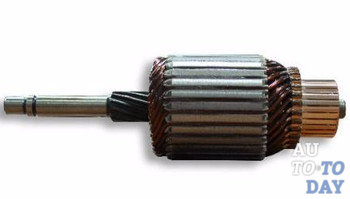 This algorithm for carrying out diagnostic work is suitable for many cars, both modern foreign cars and domestic old-timers. But we repeat once again: the main condition is the voltage of the on-board network, equal to 12 V.
This algorithm for carrying out diagnostic work is suitable for many cars, both modern foreign cars and domestic old-timers. But we repeat once again: the main condition is the voltage of the on-board network, equal to 12 V.
Subscribe to our feeds
How to check a car generator with your own hands
The generator plays a very important role in the car, for the engine it is like a mini power plant that supplies the entire on-board network of the car, including the battery (battery). A malfunction of the generator will lead to the inevitable complete discharge of the battery, after which the engine of your car will simply stop working, as well as the entire on-board network. As a result, you will have to "light up" your car or look for a new source of energy. It is very important to detect a generator malfunction in time in order to prevent the above scenario. In order to diagnose the generator, you need to have certain skills and tools. In this article, I will tell you how to check the generator at home with a multimeter.
To begin with, about precautions and safety rules during the inspection
You need to be extremely careful and understand what you are doing in order not to inadvertently damage the generator or its parts (regulator relay, rectifier bridge diodes).
Forbidden:
Check the operability of the generator by checking it "for a spark", that is, by the short circuit method.
Connect terminal 30 (sometimes referred to as B+) to terminal 67 (D+) or ground.
Allow the generator to operate when consumers are turned off, for example, when it is disconnected from the battery.
Check generator valves for voltages above 12 V.
It is possible and necessary:
Check the alternator for damage with a voltmeter or ammeter.
During welding work on the car body, it is necessary to disconnect the wires from the generator and battery.
During the replacement of wiring in the generator system, the wires must have the same cross section and length as the "native" wires.
Before checking the alternator, make sure that the alternator belt is properly tensioned, and that all connections and terminals are in good condition. The tension of the belt is considered normal, at which pressing the middle of the belt with your thumb, it will bend no more than 10-15 mm.
Do-it-yourself car generator check
To check the voltage regulator, you will need a voltmeter with a scale from 0 to 15 V. Before proceeding with the test, let the motor run at medium speed with the headlights on for about 15 minutes. Check the voltage between the "ground" of the generator and the terminals "30" ("B+"), on the voltmeter you should have a normal voltage for your car (for the owners of the "nine", for example, the voltage is considered normal - 13.5 - 14.6 V ). If the voltage is higher or lower than that set by the manufacturer, the regulator will most likely need to be replaced. It will not be superfluous to also check the regulated voltage, for this, connect a voltmeter directly to the battery terminals. True, the results of such a check cannot be considered 100% correct, because there is a possibility of problems with the wiring. If you are confident that the wiring is correct, then the results can be trusted. The motor must operate at high speeds, which are close to maximum, the headlights and other consumers of the car's electricity must be turned on. The voltage size must match the parameters of your car.
Diode bridge
Checking the diode bridge refers to a set of checks on the generator. In order to check the diode bridge, connect a voltmeter or multimeter to the “30” (“B+”) terminal of the generator, as well as to the “ground”, and turn on the device in the alternating current measurement mode. Alternating current on the diode bridge should not exceed 0.5 V, if you have more - most likely the diodes are faulty.
Breakdowns to "mass"
Checking penetration for “mass” will not be superfluous if “the gene composts brains”. To do this, disconnect the battery and the generator wire that goes to terminal "30" ("B +"). After that, connect the device between terminal "30" ("B +") and the disconnected wire of the generator. We look at the readings - if the discharge current on the device exceeds 0.5 mA, most likely there is a breakdown of the diodes or the insulation of the generator windings.
Recoil current
The recoil current strength of the generator is checked using a special probe ("lotion" addition to the multimeter in the form of a clamp or tongs), with which the wire is covered, thereby measuring the current flowing through the wire.
To check the recoil current, you need to clasp the wire that goes to the “30” (“B+” terminal) with a probe.
Start the engine - during the measurement, it should run at high speed.
Turn on the electrical consumers in turn and read the readings of the device separately for each consumer.
At the end of the measurements, you need to calculate the sum of the readings. Next, turn on all consumers (which you turned on one by one) at the same time and measure the multimeter readings. The value should not be less than the sum of the readings of separately measured indicators, the allowable discrepancy is 5 A.
Generator excitation current is checked by starting the engine and then running it at high speed. After that, the measuring probe is placed around the wire leading to terminal 67 (“D+”). A serviceable generator should show the value of the excitation current - equal to 3-7 A.
Winding check
To check the excitation windings, you will need to remove the voltage regulator, as well as the brush holder. If necessary, clean the slip rings and check the winding for breaks and shorts to ground. It is necessary to check with an ohmmeter, its probes are applied to the slip rings, after which readings are taken. The resistance should be between 5 and 10 ohms. Then connect one electrode of the device to any of the slip rings, and the other to the generator stator. The display should show an infinitely high resistance, otherwise, the excitation winding closes to ground somewhere.
Posted April 7, 2015 6:53pm UTC by Vladimir
We all know and understand perfectly well that the generator for any car is an important and responsible unit. His work must be impeccable. If there is a problem with this element, then you need to know how to check the generator. Of course, you can simply contact the service, which today is more than enough. The same article is for those who are trying to understand their car and do something with their own hands. Not a single car is insured against breakdowns, even if it is an expensive and prestigious foreign car.
Signs of a generator failure - diagnostics
Generator failures can be of a different nature and they also manifest themselves in different ways. First of all, attention should be paid to the generator if there are problems with or extraneous noise is emitted. Mechanical problems are most easily identified. They can be expressed in whistles, squeals, noises, etc. The reason in this case is the bearing. Maybe it will be enough just to lubricate it, or it may have to be replaced if it is heavily worn. But not only bearings can be the case if noise and howl are observed. The problem may be related to the short circuit of the windings, both the traction relay and the stator. A short to ground is also possible.
Checking the generator with a multimeter
The performance of the generator can be checked without removing it from the car using a multimeter by connecting the probes from the device to the battery. With the engine off, the battery voltage should be about 12.6 V. If this reading is less, then the battery should be charged. Next, start the engine. With an increase in speed, the charge voltage should increase and settle within 14.5 V. If there is no battery charge, then the generator needs repair.
Dismantling the generator
After the generator has been checked on the car, we proceed to dismantle it. To do this, you will need to disconnect the negative battery terminal. Next, remove the voltage regulator. Perform an external inspection before disassembling the generator. This applies to slip rings and brushes. Perhaps they have severe wear or soot. In the case of soot, grind the contact rings.
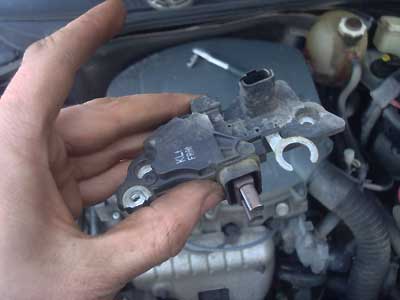
Quite often, problems with the generator are associated with the voltage regulator. It is better to have this part in stock and carry it with you, it will not take up much space, but it will save time, money and nerves. How to check the voltage regulator, consider below. If the problem was in it, then we change the part to a new one, and install the generator in its place. By the way, depending on the brand of car, it may not be necessary to remove the generator to replace the voltage regulator. After that, we start the engine again and check its performance with a multimeter. As already mentioned, the normal charge voltage should be up to 14.5 V.
Checking the electrical part of the generator
Voltage regulator. Checking this element is quite simple. This will require an external power source with an adjustable voltage from 12 V to 16 V. To check the relay-regulator, the power source is connected with a positive wire to the output contact, and a negative wire to ground. A load in the form of a 12 V car light bulb with a power of 1-3 W will be connected directly to the brushes. By gradually increasing the supply voltage, the lamp should go out. As a rule, this should happen when 14.5 V is reached. In this case, the regulator is considered to be working. In the event that the lamp does not go out when the voltage increases, it means that there is a break in the regulator, possibly between the brushes and the terminals of the regulator.

Diode bridge. In the diode bridge of the generator, diodes may fail, which is usually associated with water ingress or in the “ ” process. To check the diode bridge of the generator, a multimeter will again come to the rescue. We remove the diode bridge from the generator. You will have to check each diode separately. We set the multimeter to “ringing”, i.e. when it is possible to determine k / z. You can also select the position for testing diodes or simply 1 kΩ. With the probes of the device, we touch the terminals of the diode, after which we change the probes in places.
When measuring in one direction, the device should show a resistance of 400 to 800 ohms, in the other there should be no readings. In this case, the diode is considered serviceable. If in one and the other direction the device does not show resistance, then this indicates a break in the diode. If the resistance is too small compared to the indicated one, or the same in both directions, then the diode is broken. A defective diode must be replaced. If it is not possible to replace it, then you will have to change the diode bridge.

Excitation windings. When checking the car generator with a multimeter, we determine the resistance of the excitation winding. To do this, touch the contact rings with probes. Readings of 5-10 ohms are considered normal. To check whether there is a short to ground or not, you can attach the probe of the device to the generator stator, the second you need to touch the contact ring. If there is no short circuit, then the readings of the device will be infinite, i.e. for a multimeter, this will be “1”.

How to check the excitation current of the generator
To check the excitation current, you will need a multimeter with clamps and an additional pair of hands (assistant):
- We start the engine and bring the speed to 3 thousand rpm.
- On the device, select the current measurement mode and place the excitation wire (“67” or “D +”) inside the clamps. The multimeter reading is the excitation current. With a working generator, the current should be in the range of 3-7 A.
How to check the recoil current
Again, you need a multimeter with clamps. The procedure is similar to the previous one:
- We start the engine and increase the speed.
- With the help of pliers, you need to grasp the wire going to the “30” or “B +” contact.
- It is necessary to turn on the energy consumers in the car in turn and record the readings of the device, i.e. turned on the dipped beam - recorded, turned off. Then they turned on the distant one - they recorded it, turned off the heater, etc.
- We calculate the readings by summing them up.
- Next, you need to turn on all consumers and record the readings of the device.
- We compare the readings - they should not differ by more than 5 A.
How to avoid generator problems
To prevent problems with the generator from taking you by surprise, you must adhere to the following recommendations:
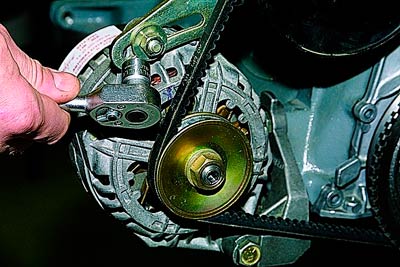
- check the alternator belt tension from time to time;
- periodically it is necessary to clean and tighten the contacts in the electrical wiring of the car. Indeed, moisture, whatever one may say, gets into the engine compartment;
- if the battery indicator lights up, you need to take measures to find and eliminate the malfunction, and as soon as possible;
- if welding work is carried out on the car body, it is necessary to remove the terminals from the generator and battery.
Checking a car generator at home is not difficult. If repairs are required, depending on the breakdown, then a special tool may be needed. In any case, everyone decides for himself whether to repair the car himself or go to the service station.





